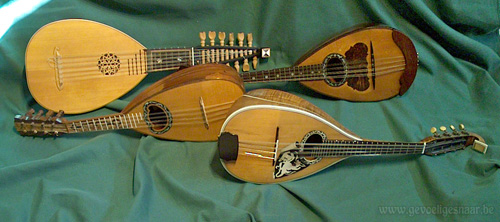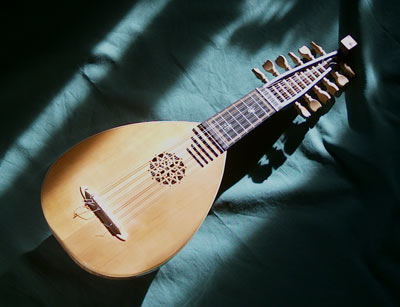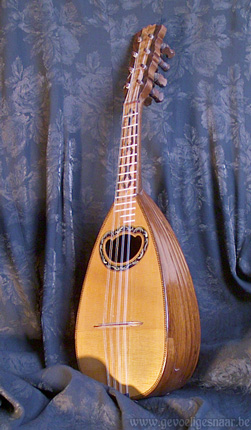|
|
|
|
From left to right: a Milanese baroque mandolin of Alex Vervaet, a Napolitan baroque mandolin of Kristof Braekman and two current Napolitan mandolins, the one in front from Luigi Embergher |
||
1. The baroque mandolin There are different types of mandolins. The typical type used in academies as well as mandolin orchestras is the most common one, the Neapolitan mandolin. It is a necessity that mandolin teachers are familiar with the history of the mandolin and its literature. Now follows a brief history. The mandolin is a soprano instrument which belongs to the lute family. In the second half of the 17th century there were two types of mandolins. The first had the shape (and the parts) of a Renaissance lute, with the following marks: In the 17th century this baroque mandolin was called mandurina, mandola, mandolino, mandürchen or bandürchen. At that time a quill was used as plectrum or a wooden plectrum from cherish bark. From this type developed a new mandolin which received the name of Milanese or Lombardic mandolin in the 19th century. It was build more heavy, with brass frets and six single strings. Since some years the mandolin regains attention. Especially in Germany some mandolinists prefer this type of instrument to interpret older pieces originally. The famous composer Antonio Vivaldi (1678-1740) wrote four compositions for the baroque mandolin: A second type was the forerunner of the Neapolitan mandolin. This type has the following characteristics: As far as we know in the 17th century two types of mandolins existed in this type: There is a detailed description of the Genoese mandolin in the oldest found mandolin method of Francesco Conti (1682-1732), edited in the beginning of the 18th century. Picture on the right: baroque mandolin made by Alex Vervaet |
||
|
The exact moment of origin of the Neapolitan mandolin has not been exactly defined. The estimates of the musicologists are spread from 1650 to 1750. On this very moment the Neapolitan mandolin is the most spread. This mandolin has four double strings tuned e" - a' - d' - g. The compositions of which we know they are written for the Neapolitan mandolin are dated 1750. The instrument possessed the earlier described building marks with brass frets. From a description of 1760 one seemed to use different material for each of the strings: - the g string was made of gut encapsulated with threads of silk or silver As plectrum a quill was used or one made from cherish bark. The mandolin attained its classical prime in the second halve of the 18th century. The These study methods give detailed indications how the mandolin was played in the 18th century. The main techniques were: - the one tone touch (the downward touch over two strings and the upward touch with one string) Between this study methods that of Gabriele Leone prevails: it is regarded as the greatest school of mandolin play. The indications written in that give the current mandolinists the opportunity to collect authentic information on the historical treatment of the instrument as well as playing techniques, to compare with the study methods of Leopold Mozart and Joachim Quantz to the violinists and flutists. The mandolin was a beloved chamber music instrument in the 18th century. This is proven by lots of found works in different strength. In the Kulturkreis of Vienna for instance there were some compositions for mandolin and string quartet, which proves that the mandolin had its place in the official music life. Except many small masters some well-known composers wrote mandolin music, as Johann Adolf Hasse (1699-1783), Carl Stamitz (1745-1801), Wolfgang Amadeus Mozart (1756-1791), Ludwig van Beethoven (1770-1827) and Johann Nepomuk Hummel (1778-1837). In numerous opera's and oratories from the 18th century one can find a mandolin part, for instance with Caldara, Conti, Händel, Hasse, Galuppi, Jomelli, Gretry, Salieri and last but not least W. A. Mozart. This tradition remained until this moment. We can also find mandolin parts in the opera's of Verdi, Schrecker, Pfitzner, Schönberg, Stravinsky, Hindemith, Fortner, B. A. Zimmermann, Ligeti, Henze, and others. To the end of the 18th century the guitar as well as the mandolin evolved from the chorus strings towards the single ones. Bartolomeo Bortolazzi (ca. 1770-1840) gives in his mandolin method - which appeared in 1805 - a description of the Cremona mandolin, which has the building style of the Neapolitan mandolin, but is stringed with four gut strings and was played with a plectrum of cherry bark. In the 19th century the mandolin disappeared from music life as a result of the changed music style. The instrument lived on in the Italian folk music. The techniques of classical mandolin masters became forgotten. The tremolo became the main playing technique in which one tried to imitate the bowed tone of the violin. Picture on the right: Neapolitan mandolin |
||
3.
First revival of the mandolin in Italy Nevertheless about 1870 rose a survival of the mandolin art of playing in Italy. Musicians as Carmine de Laurentis, Raffaele Calace, Carlo Munier and Silvio Ranieri shaped the mandolin into a virtuous instrument and wrote studies about the "romantic mandolin". Meanwhile changes were done to the building of the mandolin. Raffaele Calace (mandolin virtuoso, composer, teacher and builder) from Naples and Luigi Embergher from Rome developed the concert mandolin. The tuning pegs which where originally wooden, were replaced by a peg mechanic in a closed or a pierced top edge. From 1835 on steal strings were used for the mandolin. They were developed by Pasquale Vinaccia originating from a famous family of instrument builders. Since about 1940 the instrument is stringed with tied up steel wire for the g, d'- en a'-string. For the e'-string chrome steel is used. The scale remained on 33 cm. The sound box was enlarged and the fingerboard becomes longer: In the 19th century the first mandolin quartets arose. Their strength was: From this strength rose the current mandolin orchestras in Italy, Germany, Belgium, Netherlands, France and Austria. Originally this orchestras played popular, light classic and romantic works composed originally for string quartet. As a result the mandolin music lost connection with the musical development of the 20th century. Picture on the right: current mandolin and mandola |
||
4. Revival of the mandolin from Germany In Germany the mandolin education heavily broke through and influenced the neighbouring countries. In 1913 Theodor Ritter wrote e mandolin method in five parts mainly based on the style influences of the 19th century. The mainly used technique was the tremolo. Later on Konrad Wölki buried himself in the history of the mandolin. He used the romantic tremolo as well as the classic tough, which resulted in the mandolin method "Deutsche Schule für Mandoline" (1939). After e beak caused by the Second World War a new direction came. En intensive education of amateur musicians started. The B.D.Z., the federation of German plucking musicians (mandolinists and guitarists) rose. The main contributors where Konrad Wölki, Adolf Möszner, Siegfried Behrend and the Japanese mandolinist Takashi Ochi. Composers were encouraged to write also for the mandolin. In 1971 the mandolin was accepted in the competition "Jugend musiziert", which gave a stimuli to play the mandolin, specially the German youth. A decent schooling of mandolin teachers became a necessity. In some music academies the mandolin course rose and later on also in the "Staatlichen Hochschule für Musik Rheinland, Institut Wuppertal" with Marga Wilden-Hüsgen as teacher. New music was written, old original music was made accessible. The goal was to play the music from different periods with the correct interpreted technique, as well as a conscious made musical setting. In Belgium the development of the mandolin teaching was retarded. In the beginning of the 20th century the mandolin had a right place in Belgium. The Italian mandolin virtuoso Silvio Ranieri (1882-1956) lived in Brussels. He wrote a mandolin method in four parts, from which the first two parts are still in the run. His main pupil, Florimond Costers, trained Frans De Groodt (1892-1988), who was also recognised as mandolin virtuoso world wide. The Antwerp mandolin orchestra, the royal Estudiantina La Napolitaine, with Frans De Groodt as concertmaster, captured prizes in whole Europe. Frans De Groodt became the pioneer of the mandolin teaching in Flandern, first in the "vrije muziekschool Jozef Van Poppel" in Deurne (from 1942), later on in Borgerhout (from 1946). This courses where cancelled around 1960. Some of his pupils did go on with his work. In Merksem Lucie Van Velthoven was appointed in 1952 as mandolin teacher for a municipal course at the academy. After the fusion with Antwerp this municipal course was recognised as the first official and subsidized mandolin course in Flanders. From September 1981 Marianne Verpoest became mandolin teacher in the division of Brecht, she followed Lucie Van Velthoven in Merksem in September 1988. In Brasschaat the course of the mandolin developed in good and in bad with the "free" and later on the municipal music academy. Frans De Groodt was the local mandolin teacher during the war '40-'45; Robert Janssens, founder of the "Brasschaats Mandoline-Orkest", gave course in the fifties and one of his pupils, Karel Janssens, was the local teacher from 1969 to 1990, and from 1981 together with Krista Sass. In 1990 Karel Janssens was followed by Gerda Abts. In 2010 Marian Verpoest as well as Krista Sass stopped teaching and Gerda Abts took over their mandolin lessons. In order to assure a continuation after the retirement of Van Velthoven in Merksem, and thanks to the involvement of A. De Meulder, then director of the music academy of Merksem, V. Van Puyenbroek, then head teacher guitar at the music conservatory of Antwerp, and C. Cooremans, then director of the music conservatory of Antwerp, the teaching of mandolin was officially recognised in the conservatories from September 1989. Meanwhile the new method in the art education made it possible to raise a mandolin course in all music academies. The already run music classes in Merksem (M. Verpoest) and Brasschaat (G. Abts and K. Sass), where augmented by the music academies of Lier and Wijnegem. Gerda Abts extended the mandolin classes in Lier, Nijlen, Ranst, Wijnegem and Schilde. There are also mandolin courses in the municipal music schools of Aarschot and Linden-Lubbeek, as well as some youth music schools in the provinces of Antwerp, Limburg and West-Vlaanderen. In the years 80 initiatives were taken in Flanders as well as in the Walloon provinces to make the mandolin more public. Robert Janssens published his "Geschiedenis van de mandoline" (Antwerpen - Metropolis). In Malmedy a biennial "Festival de la Mandoline" was organised from 1982. The "Brasschaats Mandoline-Orkest" brought 1 LP and it's first CD's. September 1988 the "Vlaamse Mandolinefederatie" was founded to stimulate the contacts between the different mandolin orchestras and to propagate the mandolin and its music. G. Abts founded the "Antwerps mandolineorkest" and also Boechout got its own orchestra. In 2009 the mandolin landscape is totally changed. The Antwerp and Bouchout mandolin orchestras ceased to exist. That of Brasschaat remains however (conducted by Marcel De Cauwer) with regular performances and different CD's. Also the more decent "La Napolitaine" remains active. In the summer of 2009 M. Verpoest en K. Sass gave up teaching mandolin and G. Abts took their pupils over. The latest now teaches at Lier, Schilde, Broechem, Wijnegem, Merksem, Sint-Job in 't Goor, Brasschaat, as well as the Antwerp conservatory. Mart De Leeuw became the first student at the conservatory since 17 years. So there is still hope for a future for this beautiful instrument in Belgium. This historical essay was written by Gerda Abts, with the help of Marga Wilden-Husgen, professor mandolin at the Staatlichen Hochschule für Musik Rheinland, Institut Wuppertal. © Copyright Gerda Abts 1993
|
||
Archives Forerunners of the mandolin. Examples from old Egypt: plucked instruments, played with a plectrum, contrary to the Perzian setar and the Turkisch saz, on the illustrations a long plectrum, hold at the end with thumb and index finger.
Christodoulos Halaris edited a number of CD's with written ancient Byzantin music, discovered in the archives of the Mont Athos monasteries. The old instruments were reconstructed as good as possible, with between them a plucked instrument, as one can see on the illustration clearly played with a plectrum: a long quillt.
In the Middle Ages there were two types of quinthera or quiterne: one with three (or more) single strings and one with four double strings, both played with a plectrum.
Example of an old Italian mandolin quartet:
Between 1890 and the first part of the 20th century the mandolin was enormous popular in the United States, imported by the Italian emmigrants. The mandolin played solo there, in duo's, unto mandolin orchestra's, supplemented with guitars, harp guitars, bass harp guitars, lyre guitars, harps or cello's. They florished mainly in the amusement sector and brought walzes, song accompaniment, light classic, marzes, ragtime and cakewalks. In Boston, Washington, Philadelphia, New York and Kansas City each college had its own mandolin club. There were also professional players. The Italian Guiseppe Pettine emigrated to America, gave concerts everywhere and edited a mandolin method in six volumes in 1896. Valentine Abt showed the possiblities of the mandolin as solo instrument en founded the first American classic plectrum quartet, with two mandolins, a mandola and a mandocello. Now there is a new craze with makes the mandolin very populair again: the bluegrass. (From History of the Mandolin in America on mandolincafe.com) Under: three illustrations from the site harpguitars
Steinway mandolin orchestra
From an undated (c.1900) Rudolph Wurlitzer Co. brochure on Brandt mandolins.
The Knutsen family with two harp guitars by Chris J. Knutsen, who's real name was Johan Christian Kammen (photo 1897)
Example of a current bluegrass band (New England), with the flat folk mandolin Electric mandolin is very popular in Amerika. It has all the capabilities of the electric guitar, moreover tremolos. A collage with some examples. The double arm instruments are mandolin-mandolo combinations. |
||
















